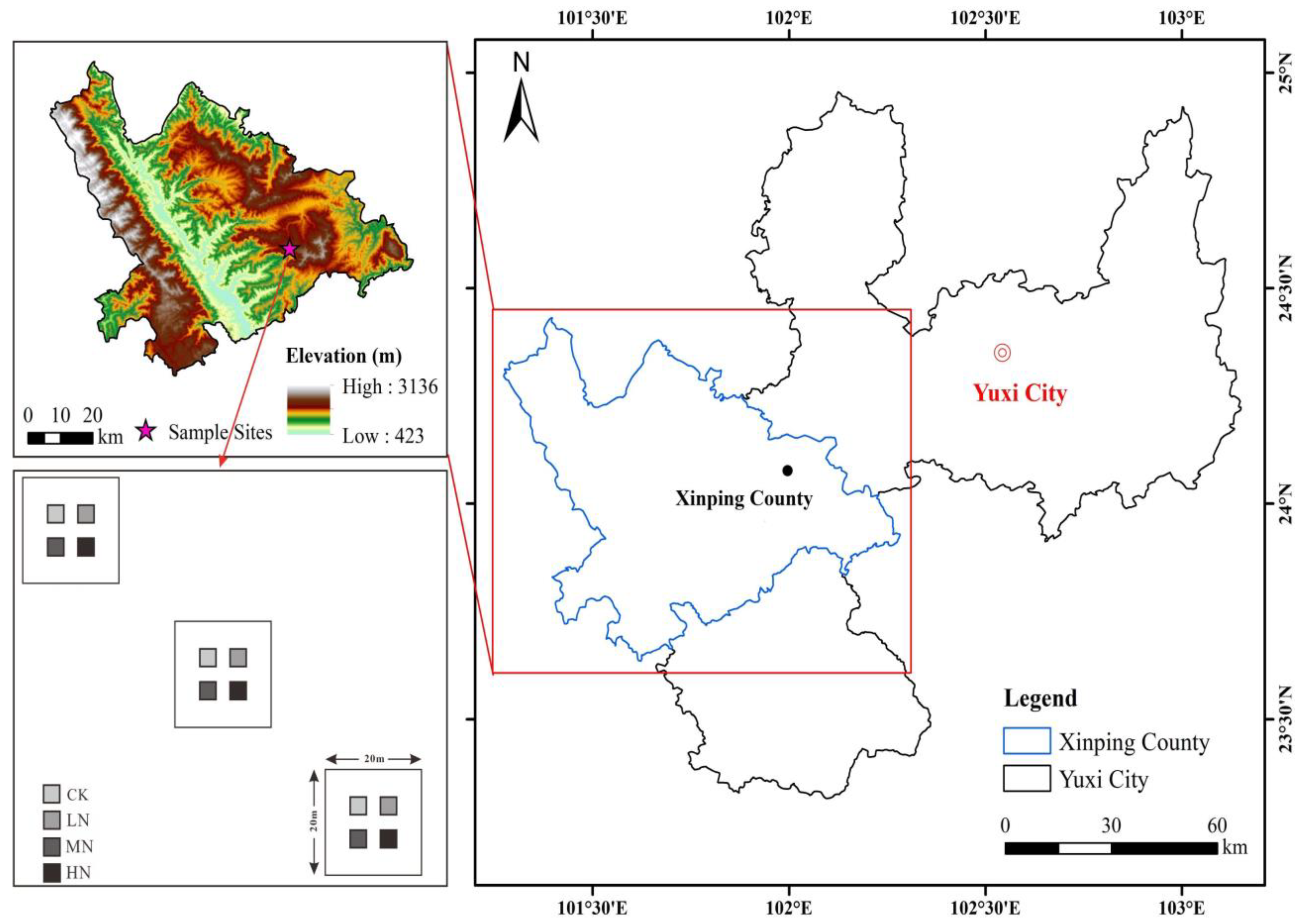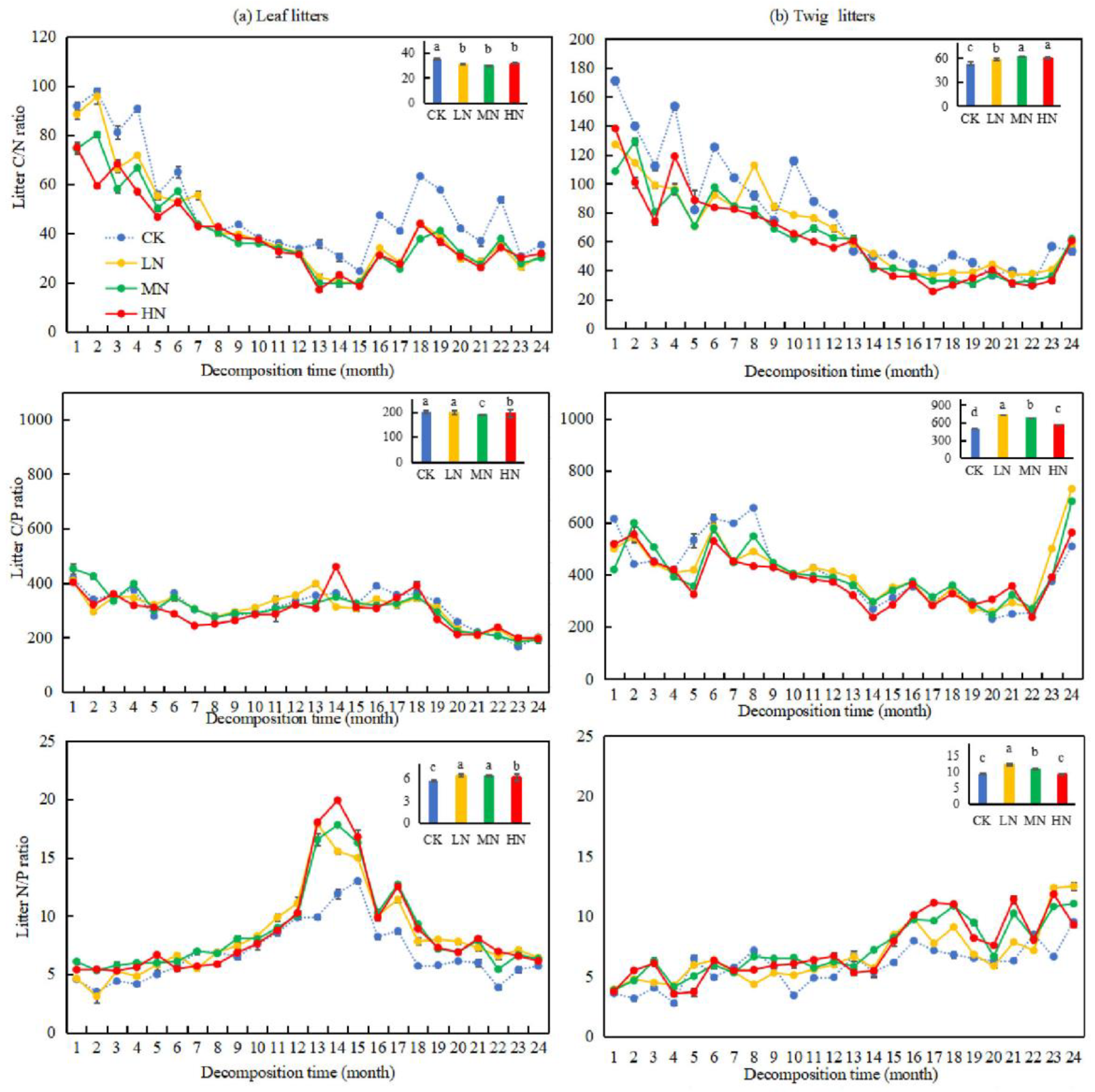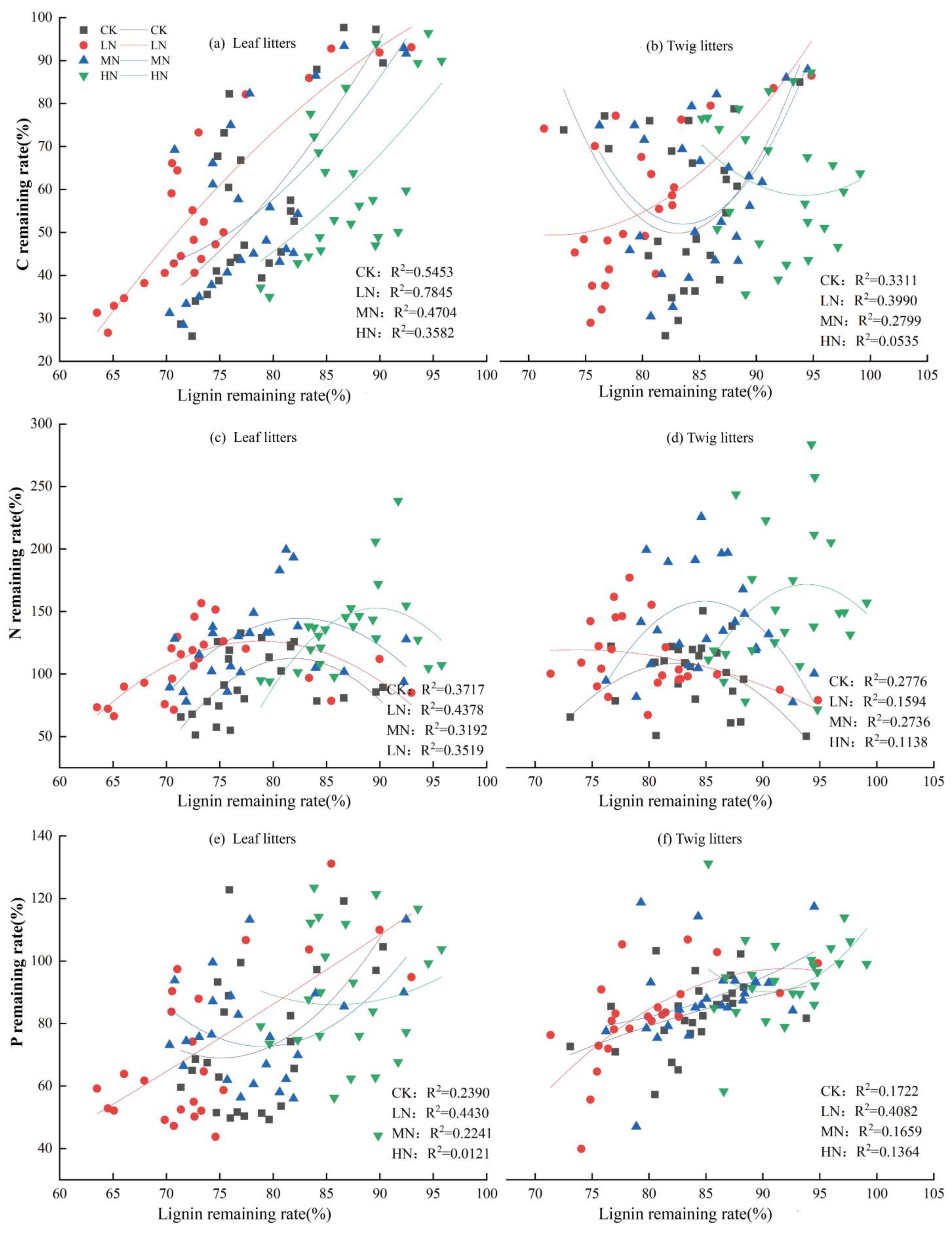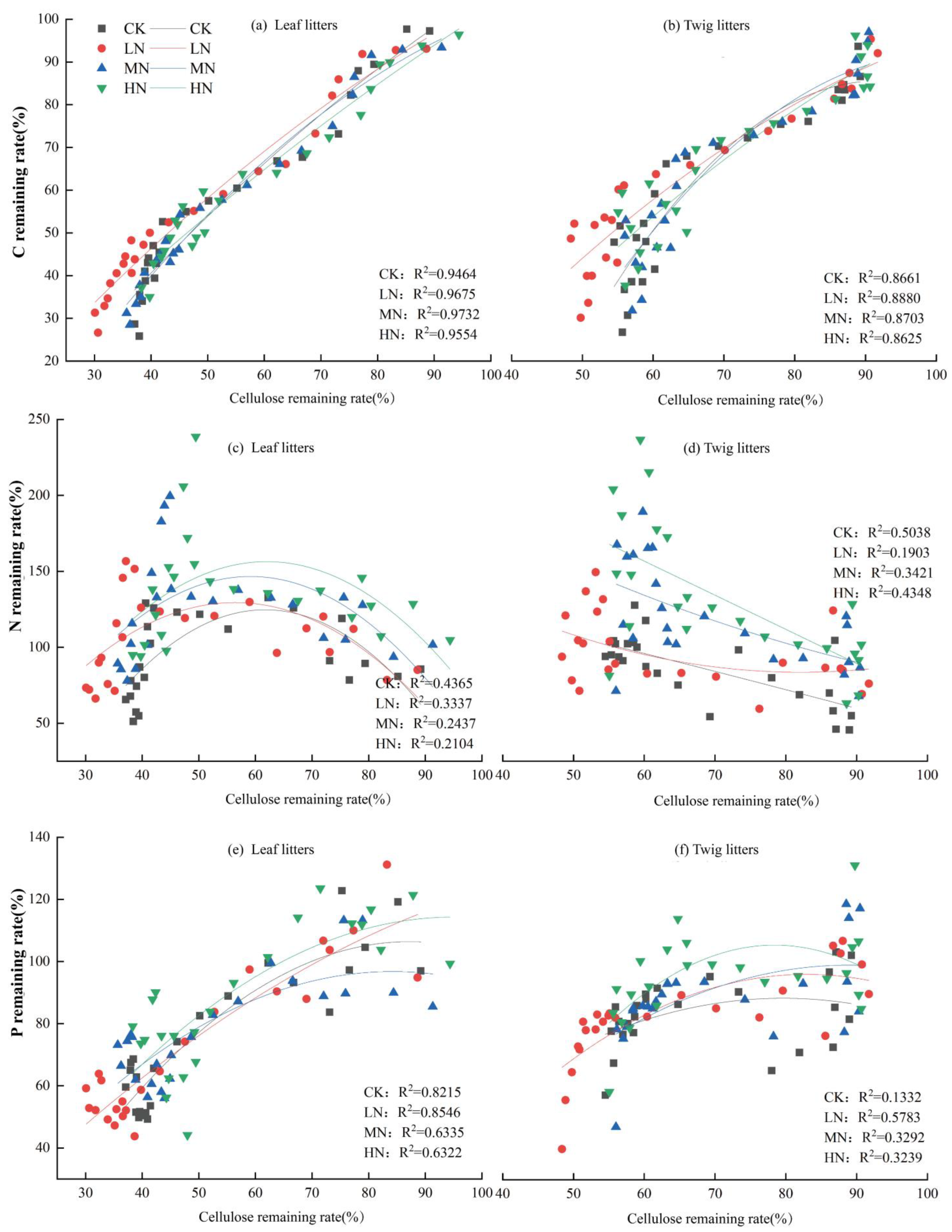Response of Litter Decomposition and Nutrient Release Characteristics to Simulated N Deposition in Pinus yunnanensis Franch. Forest in Central Yunnan Plateau
Abstract
1. Introduction
2. Materials and Methods
2.1. Study Area Overview
2.2. Methodology
2.2.1. Plot Selection and Experimental Design
2.2.2. Sampling and Index Analysis
2.3. Parameter Analysis
2.4. Data Analysis
3. Results
3.1. Effect of Nitrogen Deposition on the Decomposition Rate of Litter in Pinus yunnanensis Forests
3.1.1. Effect of Nitrogen Deposition on the Rate of Remaining Mass in Litters
3.1.2. Fitting Model of the Decomposition Rate of Litters in Pinus yunnanensis Forest
3.2. Impact of Nitrogen Deposition on the Remaining Lignin and Cellulose Rates in Pinus yunnanensis Forest
3.2.1. Effect of Nitrogen Deposition on the Lignin Remaining Rate of Litters in Pinus yunnanensis Forest
3.2.2. Effects of Nitrogen Deposition on Cellulose Remaining Rate of Leaf and Twig Litter of Pinus yunnanensis Forests
3.3. Effect of Nitrogen Sedimentation on the Remaining C, N, and P Rates in Litter of Pinus yunnanensis Forests
3.4. Stoichiometric Ratio of Litter in Pinus yunnanensis Forests
3.5. Nutrient Release from Litters and Lignin and Cellulose Remaining Rates
3.5.1. Correlation Between Lignin Remaining Rate and Nutrient Remaining Rate in Leaf and Twig Litter
3.5.2. Correlation of Cellulose Remaining Rate of Leaf and Twig Litters with Their Nutrient Remaining Rates
4. Discussion
4.1. Decomposition Characteristics of Leaf and Twig Litter in Pinus yunnanensis Forest in Response to Simulated Nitrogen Deposition
4.2. Response of Nutrient Release from Leaf and Twig Litters to Simulated Nitrogen Deposition in Pinus yunnanensis Forest
4.3. Effects of Lignin and Cellulose Degradation on Nutrient Release from Leaf and Twig Litters of Pinus yunnanensis Forest
5. Conclusions
Author Contributions
Funding
Data Availability Statement
Acknowledgments
Conflicts of Interest
References
- Galloway, J.N.; Townsend, A.R.; Erisman, J.W.; Bekunda, M.; Cai, Z.; Freney, J.R.; Martinelli, L.A.; Seitzinger, S.P.; Sutton, M.A. Transformation of the nitrogen cycle: Recent trends, questions, and potential solutions. Science 2008, 320, 889–892. [Google Scholar] [CrossRef] [PubMed]
- Galloway, J.N.; Dentener, F.J.; Capone, D.G.; Boyer, E.W.; Howarth, R.W.; Seitzinger, S.P.; Asner, G.P.; Cleveland, C.C.; Green, P.; Holland, E.A. Nitrogen cycles: Past, present, and future. Biogeochemistry 2004, 70, 153–226. [Google Scholar] [CrossRef]
- Xiao, C.; Hu, Q.; Chen, X.; Zhao, T.; Guo, X.; Chen, F. Research Progress of nitrogen deposition based on bibliometrics. Acta Ecol. Sin 2023, 43, 1294–1307. [Google Scholar]
- Lin, Y.; Zheng, S.; Su, J.; Rong, J.; He, T.; Zheng, Y.; Chen, L. Analyzing the impact of simulated nitrogen deposition on stoichiometric properties and yield of Ma bamboo (Dendrocalamus latiflorus Munro) shoots, leaves, and soil substrate. Forests 2024, 15, 151. [Google Scholar] [CrossRef]
- Xiao, H.; Yang, H.; Zhao, M.; Monaco, T.A.; Rong, Y.; Huang, D.; Song, Q.; Zhao, K.; Wang, D. Soil extracellular enzyme activities and the abundance of nitrogen-cycling functional genes responded more to N addition than P addition in an Inner Mongolian meadow steppe. Sci. Total Environ. 2021, 759, 143541. [Google Scholar] [CrossRef]
- Tie, L.; Wei, S.; Peñuelas, J.; Sardans, J.; Peguero, G.; Zhou, S.; Liu, X.; Hu, J.; Huang, C. Phosphorus addition reverses the negative effect of nitrogen addition on soil arthropods during litter decomposition in a subtropical forest. Sci. Total Environ. 2021, 781, 146786. [Google Scholar] [CrossRef]
- Borer, E.T.; Stevens, C.J. Nitrogen deposition and climate: An integrated synthesis. Trends Ecol. Evol. 2022, 37, 541–552. [Google Scholar] [CrossRef] [PubMed]
- da Silva, M.E.J.; Mathe, L.O.J.; van Rooyen, I.L.; Brink, H.G.; Nicol, W. Optimal growth conditions for Azolla pinnata R. Brown: Impacts of light intensity, nitrogen addition, pH control, and humidity. Plants 2022, 11, 1048. [Google Scholar] [CrossRef] [PubMed]
- Chen, W.; Jia, S.; Wang, X.; Shao, M.; Liao, W.; Guenther, A.; Flechard, C.; Yu, P.; Zhong, B.; Chang, M. Precipitation trend increases the contribution of dry reduced nitrogen deposition. npj Clim. Atmos. Sci. 2023, 6, 62. [Google Scholar] [CrossRef]
- Meng, Y.-n.; Li, T.; Liu, H.; Li, S.-p.; Xu, Z.; Jiang, Y. Legacy effects of nitrogen deposition and increased precipitation on plant productivity in a semi-arid grassland. Plant Soil 2023, 491, 69–84. [Google Scholar] [CrossRef]
- Song, X.; Jiang, H.; Zhang, Z.; Zhou, G.; Zhang, S.; Peng, C. Interactive effects of elevated UV-B radiation and N deposition on decomposition of Moso bamboo litter. Soil Biol. Biochem. 2014, 69, 11–16. [Google Scholar] [CrossRef]
- Wu, C.; Wang, H.; Mo, Q.; Zhang, Z.; Huang, G.; Kong, F.; Liu, Y.; Wang, G.G. Effects of elevated UV-B radiation and N deposition on the decomposition of coarse woody debris. Sci. Total Environ. 2019, 663, 170–176. [Google Scholar] [CrossRef]
- Bobbink, R.; Hicks, K.; Galloway, J.; Spranger, T.; Alkemade, R.; Ashmore, M.; Bustamante, M.; Cinderby, S.; Davidson, E.; Dentener, F. Global assessment of nitrogen deposition effects on terrestrial plant diversity: A synthesis. Ecol. Appl. 2010, 20, 30–59. [Google Scholar] [CrossRef] [PubMed]
- Liu, S.; Behm, J.E.; Wan, S.; Yan, J.; Ye, Q.; Zhang, W.; Yang, X.; Fu, S. Effects of canopy nitrogen addition on soil fauna and litter decomposition rate in a temperate forest and a subtropical forest. Geoderma 2021, 382, 114703. [Google Scholar] [CrossRef]
- Wu, C.; Zhou, S.; Cheng, X.; Wei, X. Alternating processes of dry and wet nitrogen deposition have different effects on the function of canopy leaves: Implications for leaf photosynthesis. Front. Plant Sci. 2023, 13, 1105075. [Google Scholar] [CrossRef]
- Zhang, J.; Li, H.; Zhang, H.; Zhang, H.; Tang, Z. Responses of litter decomposition and nutrient dynamics to nitrogen addition in temperate shrublands of North China. Front. Plant Sci. 2021, 11, 618675. [Google Scholar] [CrossRef] [PubMed]
- Zi, H.; Hu, L.; Wang, C. Differentiate responses of soil microbial community and enzyme activities to nitrogen and phosphorus addition rates in an alpine meadow. Front. Plant Sci. 2022, 13, 829381. [Google Scholar] [CrossRef]
- Xie, D.; Si, G.; Zhang, T.; Mulder, J.; Duan, L. Nitrogen deposition increases N2O emission from an N-saturated subtropical forest in southwest China. Environ. Pollut. 2018, 243, 1818–1824. [Google Scholar] [CrossRef]
- Gundale, M.J. The impact of anthropogenic nitrogen deposition on global forests: Negative impacts far exceed the carbon benefits. Glob. Change Biol. 2022, 28, 690–692. [Google Scholar] [CrossRef]
- Fang, H.; Mo, J. Effects of nitrogen deposition on forest litter decomposition. Acta Ecol. Sin. 2006, 26, 3127–3136. [Google Scholar]
- Wang, M.; Liu, G.; Xing, Y.; Yan, G.; Wang, Q. Long-Term Nitrogen Addition Accelerates Litter Decomposition in a Larix gmelinii Forest. Forests 2024, 15, 372. [Google Scholar] [CrossRef]
- Trentini, C.P.; Villagra, M.; Pámies, D.G.; Laborde, V.B.; Bedano, J.C.; Campanello, P.I. Effect of nitrogen addition and litter removal on understory vegetation, soil mesofauna, and litter decomposition in loblolly pine plantations in subtropical Argentina. For. Ecol. Manag. 2018, 429, 133–142. [Google Scholar] [CrossRef]
- Zhou, S.-x.; Huang, C.-d.; Han, B.-h.; Xiao, Y.-x.; Tang, J.-d.; Xiang, Y.-b.; Luo, C. Simulated nitrogen deposition significantly suppresses the decomposition of forest litter in a natural evergreen broad-leaved forest in the Rainy Area of Western China. Plant Soil 2017, 420, 135–145. [Google Scholar] [CrossRef]
- Gill, A.L.; Schilling, J.; Hobbie, S.E. Experimental nitrogen fertilisation globally accelerates, then slows decomposition of leaf litter. Ecol. Lett. 2021, 24, 802–811. [Google Scholar] [CrossRef]
- Lo Cascio, M.; Morillas, L.; Ochoa-Hueso, R.; Delgado-Baquerizo, M.; Munzi, S.; Roales, J.; Spano, D.; Cruz, C.; Gallardo, A.; Manrique, E. Nitrogen deposition effects on soil properties, microbial abundance, and litter decomposition across three shrublands ecosystems from the Mediterranean Basin. Front. Environ. Sci. 2021, 9, 709391. [Google Scholar] [CrossRef]
- Luo, Y.; Chen, H.Y.; Ruan, H. Responses of litter decomposition and nutrient release to N addition: A meta-analysis of terrestrial ecosystems. Appl. Soil Ecol. 2018, 128, 35–42. [Google Scholar]
- Zhang, J.; Li, J.; Fan, Y.; Mo, Q.; Li, Y.; Li, Y.; Li, Z.; Wang, F. Effect of nitrogen and phosphorus addition on litter decomposition and nutrients release in a tropical forest. Plant Soil 2020, 454, 139–153. [Google Scholar] [CrossRef]
- Zhuang, L.; Liu, Q.; Liang, Z.; You, C.; Tan, B.; Zhang, L.; Yin, R.; Yang, K.; Bol, R.; Xu, Z. Nitrogen additions retard nutrient release from two contrasting foliar litters in a subtropical forest, southwest China. Forests 2020, 11, 377. [Google Scholar] [CrossRef]
- Schwede, D.B.; Simpson, D.; Tan, J.; Fu, J.S.; Dentener, F.; Du, E.; deVries, W. Spatial variation of modelled total, dry and wet nitrogen deposition to forests at global scale. Environ. Pollut. 2018, 243, 1287–1301. [Google Scholar] [CrossRef]
- Zhang, Y.-J.; Song, Y.-L.; Wang, K.-Q.; Yang, X.-Y.; Xing, J.-M.; Zhang, Z.-M. Responses of litter decomposition in two subalpine plantations to simulated nitrogen deposition in central Yunnan, China. Ying Yong Sheng Tai Xue Bao = J. Appl. Ecol. 2020, 31, 2523–2532. [Google Scholar]
- Yu, G.; Jia, Y.; He, N.; Zhu, J.; Chen, Z.; Wang, Q.; Piao, S.; Liu, X.; He, H.; Guo, X. Stabilization of atmospheric nitrogen deposition in China over the past decade. Nat. Geosci. 2019, 12, 424–429. [Google Scholar] [CrossRef]
- Xing, J.; Hu, C.; Song, C.; Wang, K.; Song, Y. Nitrogen Deposition Modulates Litter Decomposition and Enhances Water Retention in Subtropical Forests. Forests 2024, 15, 522. [Google Scholar] [CrossRef]
- Xiao, X.; Chen, J.; Liao, X.; Liu, J.; Wang, D.; Li, J.; Yan, Q. Ecological stoichiometry of Cinnamomum migao leaf litter and soil nutrients under nitrogen deposition in a karst region. Ecosphere 2021, 12, e03738. [Google Scholar] [CrossRef]
- Hou, E.; Luo, Y.; Kuang, Y.; Chen, C.; Lu, X.; Jiang, L.; Luo, X.; Wen, D. Global meta-analysis shows pervasive phosphorus limitation of aboveground plant production in natural terrestrial ecosystems. Nat. Commun. 2020, 11, 637. [Google Scholar] [CrossRef] [PubMed]
- Bao, S.D. Soil and Agricultural Chemistry Analysis; China Agricultural Press: Beijing, China, 2000. [Google Scholar]
- Olson, J.S. Energy storage and the balance of producers and decomposers in ecological systems. Ecology 1963, 44, 322–331. [Google Scholar] [CrossRef]
- Roeder, M.; Dossa, G.G.; Cornelissen, J.H.C.; Yang, X.; Nakamura, A.; Tomlinson, K.W. Liana litter decomposes faster than tree litter in a multispecies and multisite experiment. J. Ecol. 2022, 110, 2433–2447. [Google Scholar] [CrossRef]
- Xu, H.; Qu, Q.; Li, G.; Liu, G.; Geissen, V.; Ritsema, C.J.; Xue, S. Impact of nitrogen addition on plant-soil-enzyme C–N–P stoichiometry and microbial nutrient limitation. Soil Biol. Biochem. 2022, 170, 108714. [Google Scholar] [CrossRef]
- Jiang, X.; Wang, X.; Qiao, Y.; Cao, Y.; Jiao, Y.; Yang, A.; Liu, M.; Ma, L.; Song, M.; Fu, S. Atmospheric nitrogen deposition affects forest plant and soil system carbon: Nitrogen: Phosphorus stoichiometric flexibility: A meta-analysis. For. Ecosyst. 2024, 11, 100192. [Google Scholar] [CrossRef]
- Wu, J.; Zhang, H.; Cheng, X.; Liu, G. Nitrogen addition stimulates litter decomposition rate: From the perspective of the combined effect of soil environment and litter quality. Soil Biol. Biochem. 2023, 179, 108992. [Google Scholar] [CrossRef]
- Kong, B.; Zhou, J.; Qi, L.; Jiao, S.; Ma, L.; Geng, W.; Zhao, Y.; Gao, T.; Gong, J.; Li, K. Effects of nitrogen deposition on leaf litter decomposition and soil organic carbon density in arid and barren rocky mountainous regions: A case study of Yimeng mountain. Forests 2023, 14, 1351. [Google Scholar] [CrossRef]
- Hou, S.L.; Hättenschwiler, S.; Yang, J.J.; Sistla, S.; Wei, H.W.; Zhang, Z.W.; Hu, Y.Y.; Wang, R.Z.; Cui, S.Y.; Lü, X.T. Increasing rates of long-term nitrogen deposition consistently increased litter decomposition in a semi-arid grassland. New Phytol. 2021, 229, 296–307. [Google Scholar] [CrossRef]
- Osborne, B.B.; Soper, F.M.; Nasto, M.K.; Bru, D.; Hwang, S.; Machmuller, M.B.; Morales, M.L.; Philippot, L.; Sullivan, B.W.; Asner, G.P. Litter inputs drive patterns of soil nitrogen heterogeneity in a diverse tropical forest: Results from a litter manipulation experiment. Soil Biol. Biochem. 2021, 158, 108247. [Google Scholar] [CrossRef]
- Knorr, M.; Frey, S.D.; Curtis, P. Nitrogen additions and litter decomposition: A meta-analysis. Ecology 2005, 86, 3252–3257. [Google Scholar] [CrossRef]
- Chen, F.-S.; Wang, G.G.; Fang, X.-M.; Wan, S.-Z.; Zhang, Y.; Liang, C. Nitrogen deposition effect on forest litter decomposition is interactively regulated by endogenous litter quality and exogenous resource supply. Plant Soil 2019, 437, 413–426. [Google Scholar] [CrossRef]
- Zhang, Y.; Jin, Y.; Xu, J.; He, H.; Tao, Y.; Yang, Z.; Bai, Y. Effects of exogenous N and endogenous nutrients on alpine tundra litter decomposition in an area of high nitrogen deposition. Sci. Total Environ. 2022, 805, 150388. [Google Scholar] [CrossRef]
- Chomel, M.; Guittonny-Larchevêque, M.; DesRochers, A.; Baldy, V. Effect of mixing herbaceous litter with tree litters on decomposition and N release in boreal plantations. Plant Soil 2016, 398, 229–241. [Google Scholar] [CrossRef]
- Song, Y.; Xing, J.; Hu, C.; Song, C.; Wang, Q.; Wang, S. Decomposition and carbon and nitrogen releases of twig and leaf litter were inhibited by increased level of nitrogen deposition in a subtropical evergreen broad-leaved forest in Southwest China. Forests 2024, 15, 492. [Google Scholar] [CrossRef]
- Zhang, P.; Lin, J.; Hao, J.; Li, C.; Quan, W. Decomposition Characteristics of Lignocellulosic Biomass in Subtropical Rhododendron Litters under Artificial Regulation. Metabolites 2023, 13, 279. [Google Scholar] [CrossRef]
- Yue, K.; Peng, C.; Yang, W.; Peng, Y.; Zhang, C.; Huang, C.; Wu, F. Degradation of lignin and cellulose during foliar litter decomposition in an alpine forest river. Ecosphere 2016, 7, e01523. [Google Scholar] [CrossRef]
- Chen, B.; Yang, Y.; Chen, L.; Jiang, L.; Hong, Y.; Zhu, J.; Liu, J.; Xu, D.; Kuang, K.; He, Z. Microclimate along an elevational gradient controls foliar litter cellulose and lignin degradation in a subtropical forest. Front. For. Glob. Change 2023, 6, 1134598. [Google Scholar] [CrossRef]








| Stand | Altitude/m | Age/a | Mean Height/m | Mean Diameter/m | Canopy Density | Slope/° | Aspect | Soil Category |
|---|---|---|---|---|---|---|---|---|
| 1 | 2193 | 23 | 8.5 | 10.2 | 0.73 | 13 | NW | Red soil |
| 2 | 2185 | 25 | 11.1 | 12.5 | 0.82 | 15 | NW | Red soil |
| 3 | 2236 | 23 | 9.1 | 11.0 | 0.75 | 12 | NW | Red soil |
| Lignin mg·g−1 | Cellulose mg·g−1 | C mg·g−1 | N mg·g−1 | P mg·g−1 | C:N | C:P | N:P | |
|---|---|---|---|---|---|---|---|---|
| Leaf litters | 275.8 | 381.7 | 554.9 | 6.86 | 1.33 | 80.90 | 417.22 | 5.16 |
| Twig litters | 327.6 | 404.0 | 574.4 | 4.35 | 1.16 | 132.05 | 495.17 | 3.75 |
| Type of Litter | Nitrogen Treatment | Regression Equation | Determination Coefficient R2 | Decomposition Coefficient k/kg·kg−1a−1 | Time of Half Decomposition T50%/a | Time of 95% Decomposition T95%/a |
|---|---|---|---|---|---|---|
| Leaf litter | CK | y = 100.959e−0.516t | 0.989 *** | 0.516 | 1.34 | 5.81 |
| LN | y = 100.323e−0.516t | 0.991 *** | 0.533 | 1.30 | 5.62 | |
| MN | y = 99.834e−0.489t | 0.987 *** | 0.489 | 1.42 | 6.13 | |
| HN | y = 100.201e−0.443t | 0.989 *** | 0.443 | 1.56 | 6.76 | |
| Twig litter | CK | y = 98.027e−0.203t | 0.981 *** | 0.203 | 3.41 | 14.76 |
| LN | y = 99.790e−0.251t | 0.972 *** | 0.251 | 2.76 | 11.94 | |
| MN | y = 99.361e−0.214t | 0.983 *** | 0.214 | 3.24 | 14.00 | |
| HN | y = 99.403e−0.194t | 0.976 *** | 0.194 | 3.57 | 15.44 |
| F | ||||||||||
|---|---|---|---|---|---|---|---|---|---|---|
| Litter Remaining | Lignin Remaining | Cellulose Remaining | C Remaining | N Remaining | P Remaining | C/N | C/P | N/P | ||
| Leaf litter | T | 36.733 ** | 8.296 | 16.816 ** | 19.663 ** | 365.518 ** | 134.990 ** | 371,671.121 ** | 64,397.445 ** | 2,283,595.790 ** |
| N | 80.817 ** | 52.536 ** | 70.902 ** | 97.983 ** | 209.916 ** | 115.563 ** | 78.215 ** | 37.409 ** | 52.070 ** | |
| T × N | 0.415 | 0.106 | 0.452 | 0.397 | 17.764 ** | 8.840 ** | 450.945 ** | 1201.811 ** | 51,518.325 ** | |
| Twig litter | T | 8.154 * | 2.205 | 3.869 * | 14.875 ** | 81.294 ** | 418.533 ** | 14,416.363 ** | 17,630.788 ** | 108,625.251 ** |
| N | 34.686 ** | 46.563 ** | 35.228 ** | 51.314 ** | 132.010 ** | 77.892 ** | 48.964 ** | 29.613 ** | 68.018 ** | |
| T × N | 0.233 | 0.1152 | 0.104 | 0.564 | 7.907 ** | 6.207 ** | 1269.163 ** | 193.099 ** | 182.629 ** | |
Disclaimer/Publisher’s Note: The statements, opinions and data contained in all publications are solely those of the individual author(s) and contributor(s) and not of MDPI and/or the editor(s). MDPI and/or the editor(s) disclaim responsibility for any injury to people or property resulting from any ideas, methods, instructions or products referred to in the content. |
© 2025 by the authors. Licensee MDPI, Basel, Switzerland. This article is an open access article distributed under the terms and conditions of the Creative Commons Attribution (CC BY) license (https://creativecommons.org/licenses/by/4.0/).
Share and Cite
Nian, Y.; Chen, W.; Zhao, Y.; Hou, Z.; Zhang, L.; Liang, X.; Song, Y. Response of Litter Decomposition and Nutrient Release Characteristics to Simulated N Deposition in Pinus yunnanensis Franch. Forest in Central Yunnan Plateau. Forests 2025, 16, 684. https://doi.org/10.3390/f16040684
Nian Y, Chen W, Zhao Y, Hou Z, Zhang L, Liang X, Song Y. Response of Litter Decomposition and Nutrient Release Characteristics to Simulated N Deposition in Pinus yunnanensis Franch. Forest in Central Yunnan Plateau. Forests. 2025; 16(4):684. https://doi.org/10.3390/f16040684
Chicago/Turabian StyleNian, Yaoping, Wen Chen, Yangyi Zhao, Zheng Hou, Long Zhang, Xiaoling Liang, and Yali Song. 2025. "Response of Litter Decomposition and Nutrient Release Characteristics to Simulated N Deposition in Pinus yunnanensis Franch. Forest in Central Yunnan Plateau" Forests 16, no. 4: 684. https://doi.org/10.3390/f16040684
APA StyleNian, Y., Chen, W., Zhao, Y., Hou, Z., Zhang, L., Liang, X., & Song, Y. (2025). Response of Litter Decomposition and Nutrient Release Characteristics to Simulated N Deposition in Pinus yunnanensis Franch. Forest in Central Yunnan Plateau. Forests, 16(4), 684. https://doi.org/10.3390/f16040684







